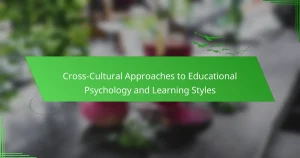Cultural norms play a crucial role in shaping student engagement and learning outcomes. They influence attitudes toward education, communication styles, and group dynamics. Understanding these norms allows educators to adapt teaching practices, fostering a supportive environment and promoting inclusivity. By integrating multicultural perspectives and recognizing diverse communication styles, educators can enhance student motivation and participation.

How do cultural norms influence student engagement?
Cultural norms significantly shape student engagement by influencing attitudes toward education, communication styles, and group dynamics. These norms affect motivation, participation, and ultimately learning outcomes. For instance, collectivist cultures often emphasize group work, enhancing collaboration and peer support. In contrast, individualistic cultures may foster independent learning, impacting engagement levels differently. Understanding these cultural influences allows educators to tailor approaches that resonate with diverse student backgrounds, improving overall educational experiences.
What are the key cultural norms affecting learning environments?
Cultural norms significantly influence student engagement and learning outcomes. Key norms include collectivism versus individualism, communication styles, and attitudes towards authority.
Collectivist cultures often emphasize group work, fostering collaboration and shared learning experiences. In contrast, individualistic cultures may prioritize personal achievement, affecting motivation and competition among students.
Communication styles vary widely; high-context cultures rely on implicit communication, while low-context cultures favor directness. This impacts classroom interactions and student participation.
Attitudes towards authority shape how students perceive teachers and educational structures. Cultures that respect hierarchy may see students less likely to question instructors, affecting critical thinking and engagement.
How do different cultures perceive education and authority?
Cultural perceptions of education and authority significantly influence student engagement and learning outcomes. In collectivist cultures, education often emphasizes respect for authority and communal learning, leading to higher engagement through group activities. Conversely, individualistic cultures promote critical thinking and questioning authority, which can enhance motivation but may also result in lower engagement in traditional settings. Research indicates that these cultural norms shape students’ attitudes towards learning, affecting their academic performance and overall educational experience.
What role does collectivism versus individualism play?
Collectivism emphasizes group cohesion, while individualism prioritizes personal autonomy. These cultural norms significantly influence student engagement and learning outcomes. In collectivist cultures, students often collaborate, enhancing group learning and support. Conversely, individualist cultures encourage self-directed learning, fostering personal responsibility and initiative. Research indicates that collectivist students may excel in collaborative tasks, while individualist students often thrive in independent assessments. Understanding these dynamics can improve educational strategies and outcomes.
How do gender roles impact student participation?
Cultural norms significantly influence student participation by shaping expectations and behaviors. Gender roles often dictate how students engage in classroom activities, affecting their confidence and willingness to contribute. For instance, studies show that traditional gender norms may discourage girls from participating in STEM subjects, leading to lower engagement levels. Conversely, boys may feel pressured to dominate discussions, impacting collaborative learning. Addressing these cultural norms is crucial for fostering an inclusive environment that promotes equal participation among all students.
What are the universal attributes of cultural norms in education?
Cultural norms in education universally influence student engagement and learning outcomes through shared values, expectations, and behaviors. These norms shape classroom interactions, teaching styles, and assessment methods. Root attributes include the emphasis on respect, collaboration, and inclusivity. Unique attributes may involve specific cultural practices that enhance learning, such as storytelling in Indigenous cultures. Rare attributes can include localized traditions that affect educational approaches, like communal learning in certain African societies.
How do cultural expectations shape student motivation?
Cultural expectations significantly influence student motivation by shaping their attitudes towards education. Cultural norms dictate what is valued in learning environments, impacting student engagement and achievement.
For instance, collectivist cultures often emphasize group success, motivating students to collaborate and support each other. Conversely, individualistic cultures may encourage personal achievement, driving students to excel independently. Research shows that students from cultures with strong academic expectations tend to perform better, as these norms foster a sense of responsibility and ambition.
Additionally, cultural values can affect students’ perceptions of authority and discipline in educational settings. In cultures that respect hierarchical structures, students may be more motivated to comply with teachers’ expectations. This interplay between cultural norms and student motivation highlights the importance of understanding diverse backgrounds in educational strategies.
What unique cultural practices enhance learning outcomes?
Unique cultural practices, such as storytelling and communal learning, significantly enhance student engagement and learning outcomes. Storytelling fosters emotional connections and retention of information, while communal learning encourages collaboration and diverse perspectives. These practices create a supportive environment that values cultural identity, leading to improved academic performance. Engaging with culturally relevant content helps students relate to their education, increasing motivation and participation.
How do rituals and traditions support student engagement?
Rituals and traditions enhance student engagement by fostering a sense of belonging and community. These practices create a shared identity among students, increasing motivation and participation. For instance, cultural celebrations can promote collaboration and mutual respect, leading to improved learning outcomes. Additionally, unique rituals may cater to diverse student backgrounds, making education more inclusive and relevant.
What is the impact of language and communication styles?
Language and communication styles significantly influence student engagement and learning outcomes. Cultural norms shape how students interact and respond to educational content.
For instance, collectivist cultures may emphasize group work, fostering collaboration, while individualistic cultures may prioritize personal achievement. These differences can affect participation levels and information retention.
Moreover, communication styles, such as direct versus indirect approaches, can impact how students perceive feedback and instruction. Understanding these dynamics allows educators to tailor their strategies effectively, enhancing overall learning experiences.
In summary, recognizing the interplay between language, communication styles, and cultural norms is essential for improving student engagement and academic success.
What rare cultural attributes can affect student performance?
Rare cultural attributes can significantly influence student performance. Factors such as collectivism versus individualism shape engagement levels. For instance, students from collectivist cultures may prioritize group harmony, affecting participation. Additionally, unique communication styles can impact classroom interaction, with some cultures favoring indirect expression. Understanding these nuances can enhance teaching strategies and improve learning outcomes.
How do socioeconomic factors influence cultural norms in education?
Socioeconomic factors significantly shape cultural norms, impacting student engagement and learning outcomes. Students from higher socioeconomic backgrounds often benefit from enriched educational resources and support, fostering greater engagement. In contrast, those from lower socioeconomic backgrounds may face barriers, such as limited access to educational materials and extracurricular activities, which can hinder their learning experiences.
Research indicates that cultural norms around education, influenced by socioeconomic status, dictate parental involvement and expectations. For example, families with higher income levels may prioritize academic achievement, leading to increased motivation and better learning outcomes for their children. Conversely, in lower socioeconomic contexts, cultural norms might emphasize immediate economic contributions over academic pursuits, affecting student engagement negatively.
Additionally, schools in affluent areas typically offer more advanced programs and extracurricular activities, reinforcing positive cultural norms surrounding education. In contrast, schools in lower socioeconomic areas may struggle with funding, leading to fewer resources and opportunities for students, which can diminish their engagement and overall academic performance.
Overall, the interplay between socioeconomic factors and cultural norms creates a complex landscape that directly influences student engagement and learning outcomes.
What are the effects of regional educational policies on cultural practices?
Regional educational policies significantly influence cultural practices by shaping student engagement and learning outcomes. These policies often reflect and reinforce local cultural norms, impacting curriculum design and teaching methods. For example, regions that prioritize collaborative learning may see higher student participation due to cultural emphasis on community. Conversely, policies that focus on standardized testing can undermine culturally relevant practices, leading to disengagement among students from diverse backgrounds. Ultimately, the interaction between educational policies and cultural practices creates a dynamic environment that affects overall educational success.

How can educators adapt to diverse cultural norms?
Educators can adapt to diverse cultural norms by incorporating culturally relevant teaching practices. This approach enhances student engagement and improves learning outcomes. Understanding students’ backgrounds fosters a supportive environment. For instance, integrating multicultural perspectives into the curriculum promotes inclusivity. Additionally, recognizing unique attributes of different cultures, such as communication styles and values, can tailor teaching methods effectively. Regular feedback from students helps educators adjust their strategies to meet diverse needs.
What strategies can teachers use to engage students from different cultures?
Teachers can engage students from different cultures by incorporating culturally relevant materials and fostering an inclusive classroom environment. Strategies include using diverse teaching methods, promoting collaborative learning, and respecting cultural differences. This approach enhances student participation and improves learning outcomes. For example, integrating stories and examples from various cultures can make lessons relatable. As a result, students feel valued and motivated to contribute, creating a dynamic learning atmosphere.
How can schools create inclusive environments for all students?
Schools can create inclusive environments by embracing diverse cultural norms, which enhances student engagement and learning outcomes. Recognizing and valuing various cultural backgrounds fosters a sense of belonging. Implementing culturally responsive teaching practices, such as integrating diverse perspectives into the curriculum, can significantly improve student participation. Additionally, training staff on cultural competence equips educators to better support all students. Schools that prioritize inclusivity often see higher academic achievement and improved social interactions among students.
What role does teacher training play in cultural competence?
Teacher training is crucial for enhancing cultural competence among educators. Effective training equips teachers with skills to understand and respect diverse cultural backgrounds, which fosters student engagement and improves learning outcomes. Studies show that culturally competent teachers can create inclusive classrooms, leading to higher academic performance and reduced dropout rates among minority students. This training often includes strategies for integrating cultural norms into lesson plans, promoting a sense of belonging, and addressing biases in teaching practices. Ultimately, well-trained teachers can bridge cultural gaps, ensuring equitable educational experiences for all students.
How can curriculum be adapted to reflect cultural diversity?
Curriculum can be adapted to reflect cultural diversity by incorporating diverse perspectives, materials, and teaching methods. This approach enhances student engagement and improves learning outcomes.
Incorporating culturally relevant content fosters a sense of belonging among students. For example, integrating literature from various cultures can enrich discussions and promote understanding.
Professional development for educators is essential. Training on cultural competence equips teachers with skills to address diverse learning needs effectively.
Assessment methods should also be diversified. Utilizing varied evaluation techniques acknowledges different cultural backgrounds and learning styles, ensuring fairer outcomes for all students.
What best practices can enhance student engagement across cultures?
Culturally responsive teaching practices enhance student engagement by acknowledging diverse backgrounds. Incorporating collaborative learning fosters a sense of belonging. Utilizing culturally relevant materials connects students to the curriculum. Encouraging student voice empowers them to share perspectives. Flexibility in teaching methods accommodates various learning styles. Building relationships with students promotes trust and engagement.
What common mistakes should educators avoid when addressing cultural norms?
Educators should avoid making assumptions about students’ cultural backgrounds. Misunderstanding cultural norms can lead to disengagement and hinder learning outcomes.
Ignoring diverse communication styles can create barriers. For example, some cultures value indirect communication, while others prefer directness.
Failing to incorporate culturally relevant materials may alienate students. Including diverse perspectives enhances engagement and fosters a sense of belonging.
Neglecting to seek student input on cultural practices can miss opportunities for collaboration. Engaging students in discussions about their cultural experiences enriches the learning environment.
What insights can experts provide on improving cultural understanding in classrooms?
Experts suggest that cultural understanding in classrooms enhances student engagement and learning outcomes. One effective approach is incorporating diverse cultural perspectives into the curriculum. This method fosters inclusivity and encourages students to connect with the material on a personal level.
Another strategy involves teacher training focused on cultural competence. Educators equipped with skills to recognize and respect cultural differences can create a more supportive learning environment. For instance, culturally responsive teaching practices can lead to increased participation and improved academic performance among students from various backgrounds.
Additionally, involving families and communities in the educational process strengthens cultural ties and enriches the learning experience. Schools that collaborate with local cultural organizations can provide students with real-world connections to their heritage, promoting pride and motivation.
In summary, integrating diverse perspectives, enhancing teacher training, and fostering community involvement are key insights for improving cultural understanding in classrooms.



